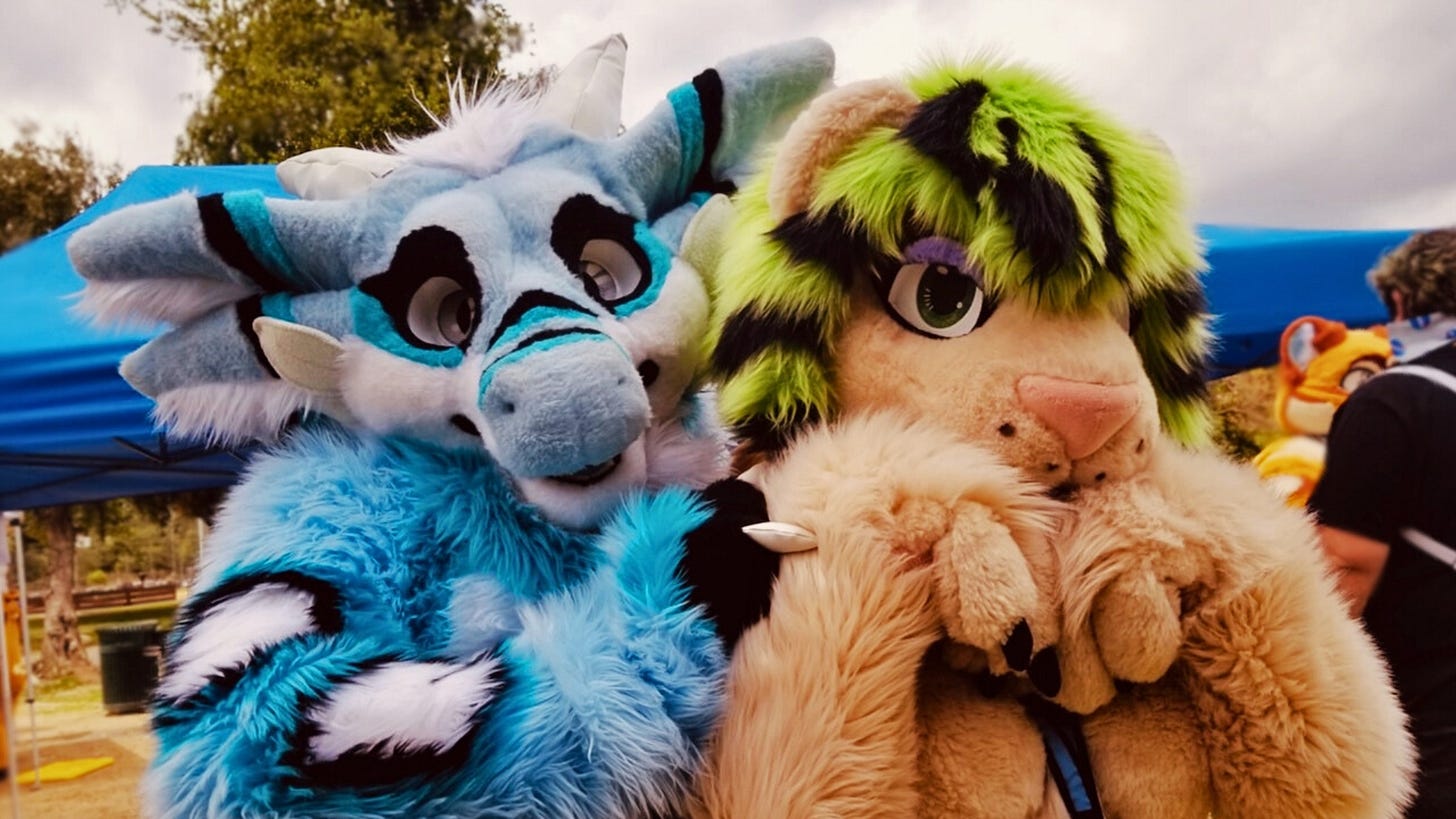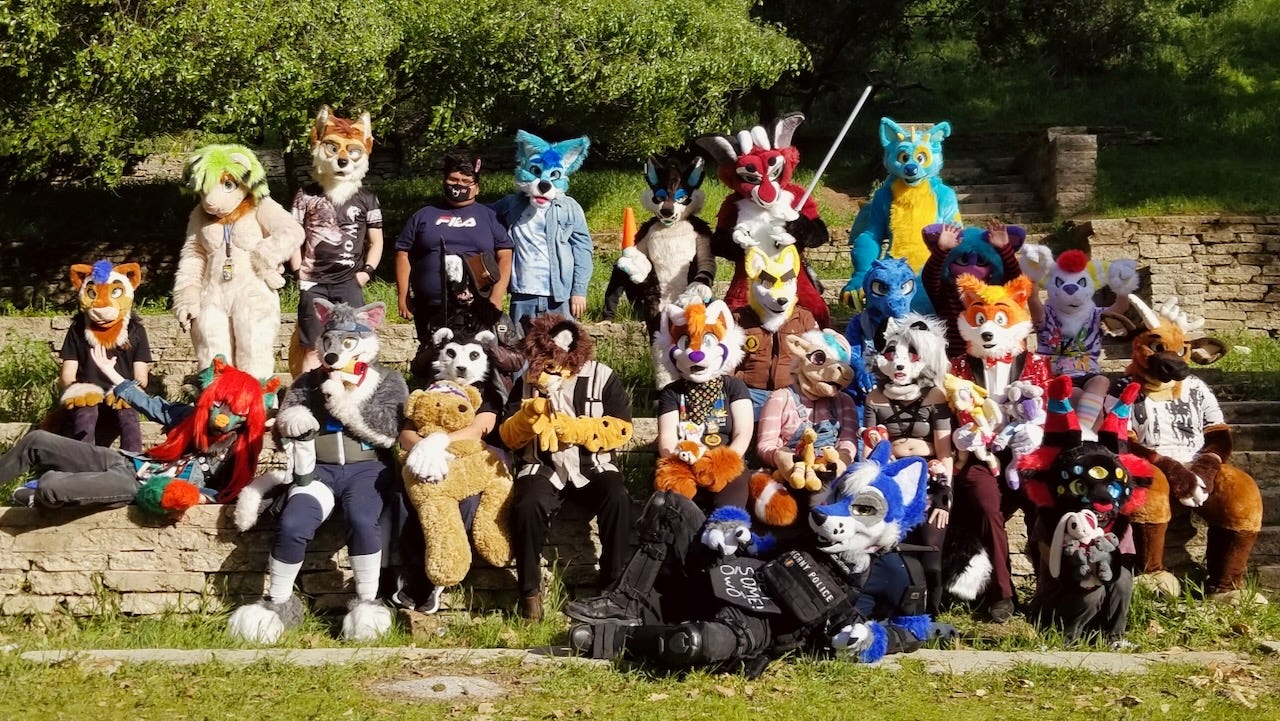We Are All Furries
Why conservatives should be celebrating the fandom instead of attacking it.
Hi there, I’m Sanjiv. Apparently you’re supposed to introduce yourself with each post, so here goes. This is a newsletter about subcultures and the ways they reveal who we are as a society. You’ll find original reporting here as well as new takes on archive stories I’ve written for GQ, Esquire, the Telegraph and others.
If you’re interested in outsiders, you’re in the right place. Consider upgrading to paid so I can keep this going!
-For about seven years now, I’ve been working on a true crime story involving furries. Not what I thought I’d be saying in my 50s, but hey. When I first embarked on this project, friends would look at me, puzzled. Ferries? Furbies? Never heard of them. So I’d explain and their expressions would morph from amusement to incredulity to the open-mouthed wow emoji 😲 as it dawned just how strange the world actually was.
Here’s what I told them:
It’s a subculture of fans of anthropomorphic animal characters who are known for wearing fursuits, like mascots or Disney characters. They hang out in parks and iHops, they go bowling and rollerskating and clubbing. And yes, from time to time, they’ll gather in a convention center in Pomona or someplace and go at it like rabbits. But that’s not the main draw. As furries will tell you, it’s a fandom not a fetish. The true allure is psychological. They create animal-based identities called fursonas which they then embody in role play, adopting the names and designing the costumes. For young people who struggle socially, because they’re on the spectrum, say, or perhaps they’re gay or trans, a fursona can help them navigate identity and relationships. It’s not hyperbole to say that the furry scene has saved lives.
These days, the explanation isn’t so necessary. People are more aware of furries than before. There’s more of them around, for one thing. If I drop the f-word, they’ll mention the furries they saw at the mall or in their kid’s class at school. Some will use “fursona” in a sentence because you get points for that LA, about as fur-forward (furward?) a city as you’re likely to find. But there have been similar sightings elsewhere. A professor friend in Memphis told me recently that he too sees furries in his history lectures now. They sit in the front rows with their fox ears twitching, the full mascot outfit minus the masks. They answer to their furry names. And after class, they go and smoke weed in the car park.
Furmongering
This growing visibility of furries has prompted predictable reactions from both left and right, each side responding in ways that seem designed to madden the other. Liberals have either rushed to embrace the cool new marginalized group, or affected a blasé shrug, as though it’s no biggie, just a badger on the bus, whatever. Meanwhile, the right sees that badger as a portent of End Times and has been pointing and shrieking like Donald Sutherland in Invasion of the Body Snatchers.
Perhaps you’ve heard of the litter box hoax by now—the rumor that schools were providing litter trays for students who identify as cats. It began as a joke in 2021, but conservatives took it literally, and then it went viral the following year thanks to the combined brain cells of Marjorie Taylor Greene, Lauren Boebert, Libs of Tik Tok etc. Here’s Nebraska Senator Bruce Bostelman imploring “how is this sanitary?” There was never any evidence, but like the Satanic Panic in the 80s, the lie travelled the world before the truth could put on its fursuit. And despite repeated debunking—in the New York Times, the Daily Beast, you can go down the list—the zombie lie has staggered forward. In January of 2024, Oklahoma Senator Justin Humphrey tried to ban all “anthropomorphic behavior” in schools, and threatened to allow Animal Control to remove violators. (The proposal didn’t pass).
In the way that wind spreads wildfires, fear spreads lies. The first casualty of culture war is truth. What began as a Swiftian satire chimed so perfectly with the right’s fears, that the litter box hoax became a way to galvanize the base and invigorate their own sense of mission. For conservatives, demonizing ‘others’ for political ends has long been their happy place, particularly LGBTQ ‘others’, who account for about 80% of furries. So, the hoax is best understood as an anti-trans dog-whistle intended for people who feel threatened by gender ideology. If identity is entirely subjective, goes the logic, then what’s stopping us from identifying as animals, real or imagined? Where does it end? This is the slippery slope that Republicans like Rick “man on dog” Santorum have been banging on about for decades. So of course their base fell for it. It felt like prophecy had come to pass.
At the risk of stating the obvious, Republicans have nothing to fear from the fandom. Furries don’t threaten their world order. I say this not as a furry myself but as someone who has been nattering with them for years, and what I’ve learned is that they are eminently relatable, especially for conservatives. You just need to look behind the mask.
Looping Effects
That’s Mark Merlino, one of the founders of the fandom. He passed away earlier this year, but before he died, we spoke several times at his house in Garden Grove, Orange County, a famous address on the furry scene. He called his home The Prancing Skiltaire and used to host the first ever furmeets there back in the 1980s.
He loved to tell me that we were all furries at heart. “You liked Tony Tiger on Frosted Flakes, didn’t you?” he said. “You enjoyed cartoons? Well then, you’ve got some furry in you!”
It’s true, we all grew up on anthropomorophic animals. To some degree all children are furries.
But our deepest connection to the fandom isn’t our love for cartoons. It’s our desire to become better versions of ourselves—2.0 with the flaws ironed out. Because that’s what most fursonas are, an aspirational upgrade of the core personality. More confident, more dynamic, more charismatic at parties. Wanting to be better is a basic yearning, and it echoes traditional conservative values of individual agency and striving (not to mention Melania Trump’s Be Best campaign). As the libertarian Leonard Read wrote, individuals should aim, not to improve “society”, but “to affect their own unfolding, the upgrading of their own consciousness, in short, self-perfection.”
We know that this works. Inhabiting an aspirational identity like a fursona can help us actually grow in that direction through a number of positive feedback loops—fake-it-till-you-make-it is not without scientific merit. There’s neuroplasticity. If I act with more confidence, then my brain will strengthen the pathways associated with those behaviors, until they become habit. Similarly when I see how others respond, it activates my “mirror neurons” which strengthen my own belief in my confidence. There’s the Proteus effect, whereby our characters are shaped by the qualities of our avatars in virtual worlds—and what is a fursona if not an avatar made flesh? Not to mention other reinforcing mechanisms like dopamine rewards and the broader looping effects that the Canadian philosopher Ian Hacking identified, through which the stories we tell about ourselves actively change who we become.
It seems furries are engaged in one of the most influential ideas of our time—the same idea behind Atomic Habits by James Clear and the entire Mindfulness Industrial Complex—that we can systematically rewire our brains to create the personalities we desire.
A Constant State of Becoming
Of course there are complications. Brain rewiring has its pitfalls. But here again, we can relate to the furries because we face the same struggles on social media. A social media avatar, like a fursona, is an enhanced self, a front that we present to the world, behind which our real self lurks, watching. And that dynamic can be treacherous if we over-rely on our avatar or over-identify with it. It takes a toll just knowing the gulf between inner and outer self, the degree to which we don’t measure up.
But the principle stands—that acting like our improved selves, even if we know it’s an act, can inch us towards the improvement we’re after. And famous conservatives agree. Here’s Jordan Peterson: “every man is an actor of his own ideal. At some point you have to act like you’re already there when you’re just barely started.” He might as well have been describing a fursona.
This is a story about identity that the right can get behind. It upholds the idea that identity is fluid, a word that can set off alarm bells on that side of the aisle. But fluid in an iterative, deliberate sense, the result of intention and effort. It’s a story that affirms our liberty as individuals to change who we might become. You can almost hear the bootstraps.
In The Sublime Object of Ideology, Slavoj Zizek described identity as “the gap between what we are and what we want to be”. The perpetual tenson between the two is the desire that drives us forward. A desire that will never be fulfilled because this is the human condition—we are in a constant state of becoming.
And that’s what a fursuit signifies. Not litter boxes in schools. Not the end of western civilization. But the simple human desire to become.
Thank you as always for your support. Before you go, check out Slow Players by Matthew Specktor. His book, Always Crashing in the Same Car, is my favorite book about Los Angeles and writing.





Bold and funny. This is such a remarkable way of bringing research and personal feeling into a piece. I really admire it for many reasons. Thank you! (Funny and awesome!)
I'm actually an economics professor. So that makes the furries stand out more in the class!